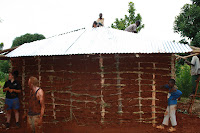Nicole a volunteer with WYI living in Mutumbu has built up a splendid relationship with a woman named Lily. Lily is deaf and a mute. You can only image the issues and struggles that can arise with being deaf and a mute in Kenya. There are no organisations or government support to help. There have been concerns about Lily and her family within the community for some time as it has been known that she has been exploited and taken advantage of. She has three children all too different fathers and there has been the suggestion that they are all the product of rape. Lily’s children are Brian (10), Vincent (7) and Oscar (3). Brian is sponsored by an organisation called Compassion which provides schooling for him and he lives with a lady Lily worked for. Lily wants Brian back, however there are complications that I cannot comment on. Nicole had taken an instant fondness to Lily and her family and decided to help. The decision was made to build a house for Lily on her families land. Lily would now not need to rent, the money can go to providing for her family and she has the safety and security of her extended family and house. Ok, now I have an exercise for you. Gee, reading a blog and I am making you work. Sorry, I just want you to really get the contrasting differences between Kenya and the Western world. I want you to think of the house you live in or the building you are in at the moment. Look around at the floor, the ceiling, the walls. Think of the processes that took place to build it. Think of the materials that were used, bricks, concrete, plaster. Look closer, at the paint on the walls, the carpet or tiles. The lights on the ceiling, the heating, cooling, ventilation. The tiny trinkets lying around on a dust covered shelf, the volts of electricity flowing through the walls. This is the Western world with much of our needs and wants. Enter the Kenyan world. The land is cleared but not leveled, tree roots sprout up in what is to be the living/everything room. The workers have gone to the river to retrieve mountains of reeds. Tree trunks and branches have been trimmed and prepared to form the structural frame. Holes are dug with a crowbar and machete to place the supporting tree trunk posts. Clumps of reeds are placed amongst the frame and tied on with string; meanwhile workers are digging up dirt with hoes and mixing with water to form a thick muddy paste. The frame is completed, the mudding to begin. Skilled workers begin on the roof as children distribute handfuls of mud around the house. All the volunteers are on hands and knees, filling in the frame with handfuls of mud. A good method is to roll your handful of mud in the dry dirt to form a kind of brick then place it in. We must work fast the rains are coming. If it rains before we are finished most of our work here has gone to waste. We work overtime, mudding, bricking. Men on the roof sit on rickety trunks which form the roof frame. Legs dangling down the side hammering in the nails. Mudding is complete; however the muddy walls do not go all the way up to the roof as a type of ventilation is needed, the crisp open air. The shiny new corrugated iron roof is placed on. The mud brick home is almost complete. A second mudding must occur in around two week’s time. The house, considerably large at around 5m x 5m is divided by a mud wall to form two rooms. Imagine living in a mud brick home. Dirt floor, muddy walls, no electricity, cool open breeze is your only type of ventilation, no insulation. Basic paraffin cooking stove, some pots and pans, a bed, maybe a wooden couch if you are lucky and some buckets for washing and cleaning. Think about it for a moment. Put yourself there. Nicole with her heart as big a giant Saharan Sasquatch is helping Lily with the basic living necessities in Kenya. Lily now has a home and a lovely one at that. A place to call her own. Although the mud brick home doesn’t sound too fancy, many last for up to 10-15 years. In Kenya it is not about the want, it is all about the need.
 |
 |



 |
| Lily, two of her boys and the volunteers |



No comments:
Post a Comment